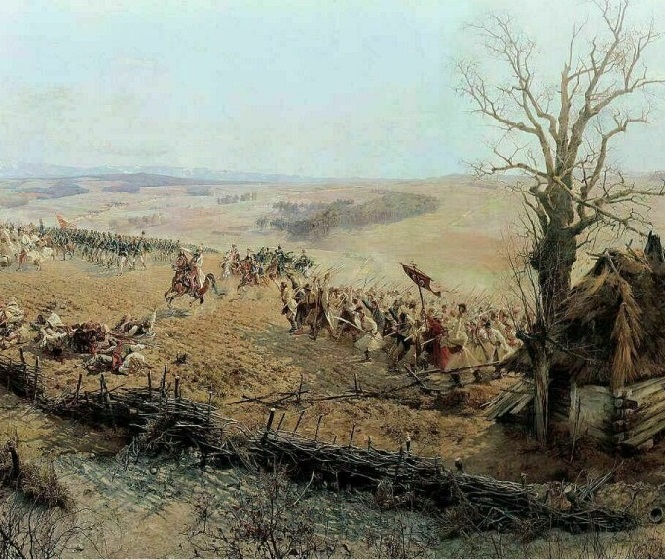HISTORY – Racławice 1794 – Kosciuszko is directing more Polish troops to the fight
A fragment of Panorama Racławicka – Kosciuszko is directing more Polish troops to the fight
Panorama of the Battle of Racławice
PANORAMA OF THE BATTLE OF RACŁAWICE in Wrocław (ul. Purkyniego 11), an impressive relic of 19th-century century mass culture, is one of only few examples of this genre preserved in Europe. The large painting (15 × 114 m) 'transfers’ the viewer into an altogether different time, a reality of its own, by artfully combining painterly devices (special kind of perspective taking into account the viewer’s viewpoint standing on the viewing platform inside the panorama building, fogging of distant objects) and technical effects (the floor and ceiling of the panorama building form a two-shell hyperbolide, lighting, artificial terrain, dark and usually tortuous passage to the viewing platform, which places the viewer in the center of the panorama). Panoram of the Battle of Racławice is the oldest and only extant example of panorama painting in Poland.
The idea came from the painter Jan Styka (1858–1925) in Lwów (Lvov) who invited the renown battle-painter Wojciech Kossak (1857–1942) to participate in the project. They were assisted by Ludwik Boller, Tadeusz Popiel, Zygmunt Rozwadowski, Teodor Axentowicz, Włodzimierz Tetmajer, Wincenty Wodzinowski and Michał Sozański.
• Jan Styka – he painted a group of peasants who won Russian cannons, the figure of the head of Kosciuszko on a horse, a figure of Wojciech Bartos Głowacki;
• Wojciech Kossak – he painted a horse near Kosciuszko, a staff heading for the commander, a group of Russian soldiers defending cannons, a national cavalry;
• Ludwig Boller – he painted the landscape and the whole sky of the painting;
• Tadeusz Popiel – he painted the landscape, all trees and peasant cottages;
• Zygmunt Rozwadowski – battle scenes under the direction of Kossak;
• Teodor Axentowicz – battle scenes under the direction of Kossak, infantry line 2 of the Crown Pedestrian Regiment gen. Józef Wodzicki;
• Włodzimierz Tetmajer – he was an expert on folklore, he painted folk costumes under the direction of Styka;
• Wincenty Wodzinowski (a student of Jan Matejko) – he painted the figure of Kosciuszko and, under the direction of Styka, folk costumes of the figure.
The project was conceived as a patriotic manifestation commemorating the 100th anniversary of the victorious Battle of Racławice, a famous episode of the Kościuszko Insurrection, a heroic but in the end fallen attempt to defend Polish independence. The battle was fought on 4 April 1794 between the insurrectionist force of regulars and peasant volunteers (awesome scythe-bearers) under Kościuszko (1746–1817) himself and the Russian army commanded by General Tormasov. For the nation which had lost its independence, the memory of this glorious victory was particularly important. The National Exhibition, organized in Lwów in 1894, offered an excellent opportunity to realize Styka`s idea. Canvas, woven to order, was bought in Brussels, the specially-built rotunda’s iron structure (designed by Ludwik Ramułt) in Vienna. The rotunda, located in Stryjski Park in Lwów, was ready in July 1893. The huge panorama painting was executed within 9 months, between August 1893 and may 1894. The official opening was on 5 June 1894. Since the very beginning, Panorama of the Battle of Racławice attracted enormous attention and brought crowds of tourists to Lwów.
After World War II, the painting was brought to Wrocław along with a part of the collection of the Ossoliński Institution. As under the Communist regime the subject was considered politically sensitive, the efforts to have the canvas restored and exhibited, undertaken by succesive Volunteer Committees, were successful only after August 1980 (SOLIDARNOŚĆ). Reopened on 14 July 1985, the major attraction of the old Lwów has immediately become the main tourist attraction of Wrocław.
Here, contemporary viewers hav an opportunity to participate in a unique illusionist spectacle. Among many guests visiting the panorama were Archduke Charles Stephen of Austria (in 1894), Franz Joseph I – Emperor of Austria (also in 1894), Pope John Paul II, Beatrix the Queen of Holland, King of the Belgians Albert II.
.
JT based among others -> https://panoramaraclawicka.pl/?lang=en [access 2018-06-28]

